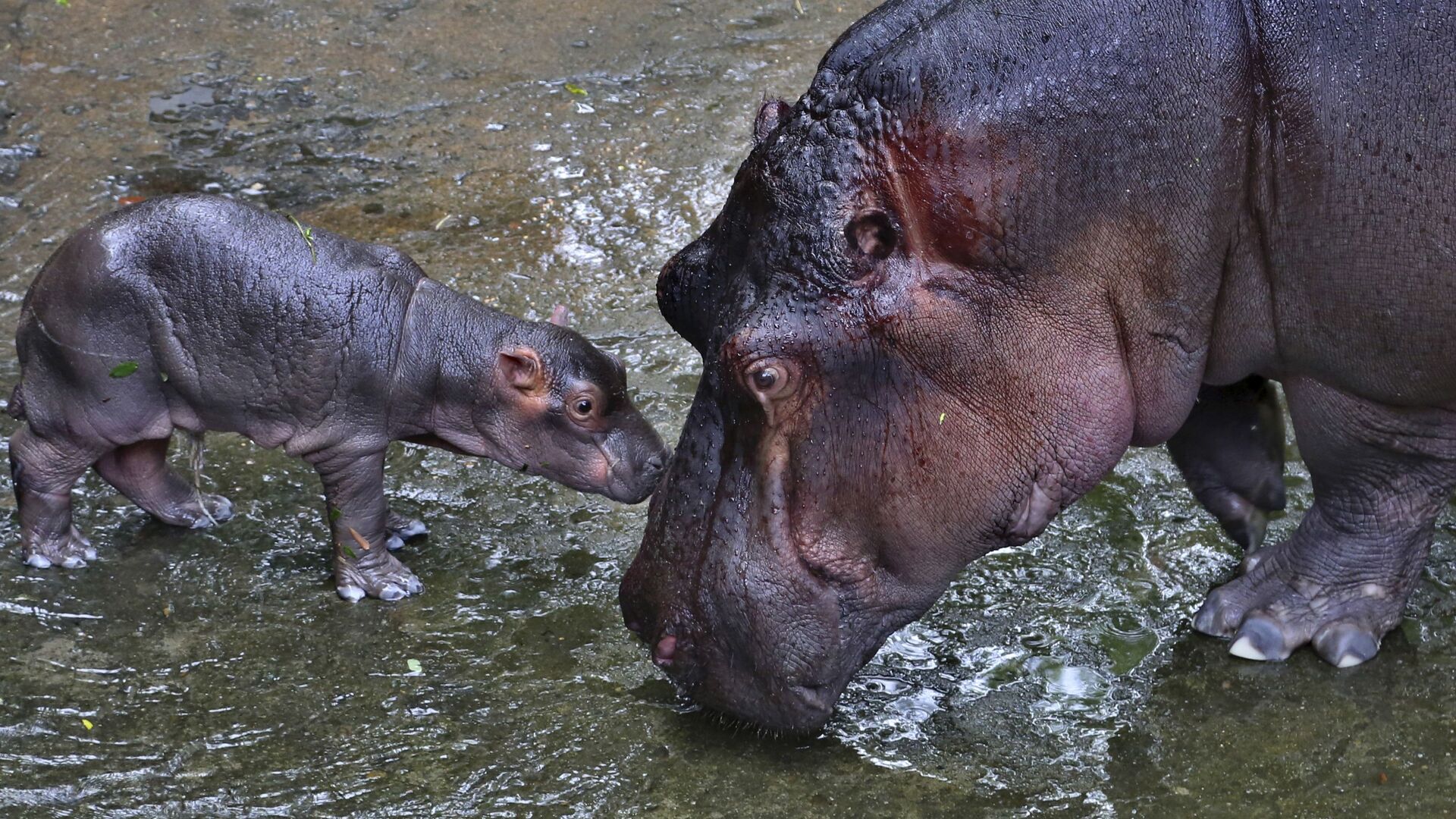Pablo Escobar’s 'Cocaine' Hippos Could Be Culled Due to 'Toxic' Poo
18:54 GMT 09.02.2022 (Updated: 13:32 GMT 06.08.2022)

© AP Photo / Aijaz Rahi
Subscribe
It’s been 29 years since Colombian law enforcement killed the infamous drug lord following his daring escape from prison. But even after his death, Pablo Escobar's legacy continues to terrorise local residents as well as the nation’s flora and fauna.
Hippos smuggled into Colombia in the 1980s by drug lord Pablo Escobar now face culling after local authorities added them to a list of "invasive species", said David Echeverri López, biologist and head of the Cornare state environmental agency.
"[Culling] remains on the table. It is a necessary option... it could be the only way to stop the problem from getting worse", he said.
Colombian authorities pledged to "manage" the hippos’ population, which burgeoned from 35 in 2012 to somewhere between 65 and 80. David Echeverri says in the coming decades this number may balloon to several hundred.
Delinquent Giants
"What have those chubby and sweet creatures done to deserve to be killed?” one may ask. Well, don’t let their cuteness fool you. They may be adorable, but hippopotamuses are one of the most dangerous animals in the world. According to the National Geographic, they kill an estimated 500 people in Africa every year.
Now imagine how dangerous the hippos are that once hung out with one of the most brutal drug kingpins, who is said to have been responsible for the deaths of 4,000 people. Jokes aside, the answer is quite banal – when Pablo Escobar brought these giant animals to Colombia, he unwittingly disturbed the natural order of things.
Now imagine how dangerous the hippos are that once hung out with one of the most brutal drug kingpins, who is said to have been responsible for the deaths of 4,000 people. Jokes aside, the answer is quite banal – when Pablo Escobar brought these giant animals to Colombia, he unwittingly disturbed the natural order of things.
It is impossible to control their population, as hippos live in an area where there are no predators hunting them. In turn, local animals cannot defend themselves against hippos, hence the adorable chubsters pose a real threat to native species, especially those that have been listed as endangered, like Antillean manatees.
It's not only their size and temper that has caused great nuisance, but their "toxic" poo. Hippos spend most of the day in lakes and waterways and, well, do their twos in there too. The faeces, or rather the ammonia, pollute the water and starve it of oxygen. As one may have guessed, the math here is rather simple – more hippos create more poo, which in turn creates more pollution and sucks more oxygen from the water, consequently killing fish and other aquatic animals.
Humans have also suffered from hippos – last year, one of the animals attacked and seriously injured a fisherman. In 2020, a man had his ribs, leg, and hip broken after a hippo flung at him.
Despite these problems, Colombians have grown fond of the giant animals, said David Echeverri López, who believes there has to be a solution to the problem. But experts believe Colombia is past the point where things could have been sorted out in a peaceful way.
Attempts have been made to sterilise the hippos, but the measure proved costly and difficult. Shooting them with contraceptives didn’t have any effect either, with their population continuing to grow.
Earlier this year, environmentalists proposed to create a sanctuary for the animals, which could have been funded by taxpayer and private funds, but the proposal was rejected as costly and harmful.
They cannot be sent back to Africa either, because the population is inbred and they may have diseases that would endanger African fauna.
It's not only their size and temper that has caused great nuisance, but their "toxic" poo. Hippos spend most of the day in lakes and waterways and, well, do their twos in there too. The faeces, or rather the ammonia, pollute the water and starve it of oxygen. As one may have guessed, the math here is rather simple – more hippos create more poo, which in turn creates more pollution and sucks more oxygen from the water, consequently killing fish and other aquatic animals.
Humans have also suffered from hippos – last year, one of the animals attacked and seriously injured a fisherman. In 2020, a man had his ribs, leg, and hip broken after a hippo flung at him.
Despite these problems, Colombians have grown fond of the giant animals, said David Echeverri López, who believes there has to be a solution to the problem. But experts believe Colombia is past the point where things could have been sorted out in a peaceful way.
Attempts have been made to sterilise the hippos, but the measure proved costly and difficult. Shooting them with contraceptives didn’t have any effect either, with their population continuing to grow.
Earlier this year, environmentalists proposed to create a sanctuary for the animals, which could have been funded by taxpayer and private funds, but the proposal was rejected as costly and harmful.
They cannot be sent back to Africa either, because the population is inbred and they may have diseases that would endanger African fauna.
